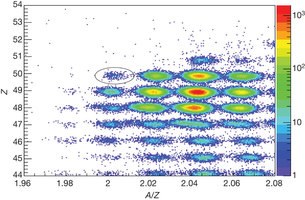Anuj R. Parikh, professor d'Enginyeria Física, ha publicat un article a Nature junt amb altres investigadors
21/06/2012
Anuj R. Parikh professors d'Enginyeria Física, junt amb altres investigadors, ha publicat un article a Nature titulat "Superallowed Gamow–Teller decay of the doubly magic nucleus 100Sn".
The shell structure of atomic nuclei is associated with ‘magic numbers’ and originates in the nearly independent motion of neutrons and protons in a mean potential generated by all nucleons. During β+-decay, a proton transforms into a neutron in a previously not fully occupied orbital, emitting a positron–neutrino pair with either parallel or antiparallel spins, in a Gamow–Teller or Fermi transition, respectively. The transition probability, or strength, of a Gamow–Teller transition depends sensitively on the underlying shell structure and is usually distributed among many states in the neighbouring nucleus. Here we report measurements of the half-life and decay energy for the decay of 100Sn, the heaviest doubly magic nucleus with equal numbers of protons and neutrons. In the β-decay of 100Sn, a large fraction of the strength is observable because of the large decay energy. We determine the largest Gamow–Teller strength so far measured in allowed nuclear β-decay, establishing the ‘superallowed’ nature of this Gamow–Teller transition. The large strength and the low-energy states in the daughter nucleus, 100In, are well reproduced by modern, large-scale shell model calculations.

The shell structure of atomic nuclei is associated with ‘magic numbers’ and originates in the nearly independent motion of neutrons and protons in a mean potential generated by all nucleons. During β+-decay, a proton transforms into a neutron in a previously not fully occupied orbital, emitting a positron–neutrino pair with either parallel or antiparallel spins, in a Gamow–Teller or Fermi transition, respectively. The transition probability, or strength, of a Gamow–Teller transition depends sensitively on the underlying shell structure and is usually distributed among many states in the neighbouring nucleus. Here we report measurements of the half-life and decay energy for the decay of 100Sn, the heaviest doubly magic nucleus with equal numbers of protons and neutrons. In the β-decay of 100Sn, a large fraction of the strength is observable because of the large decay energy. We determine the largest Gamow–Teller strength so far measured in allowed nuclear β-decay, establishing the ‘superallowed’ nature of this Gamow–Teller transition. The large strength and the low-energy states in the daughter nucleus, 100In, are well reproduced by modern, large-scale shell model calculations.

Comparteix: